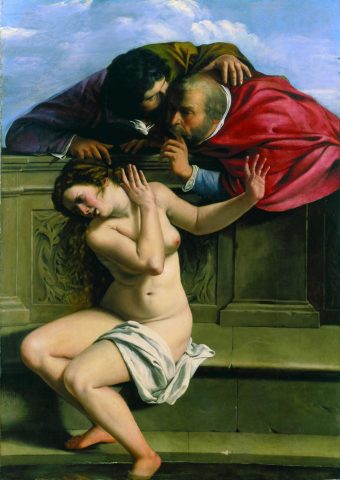Rome celebrates first female painter in art history revealing three new original pieces
- Artemisia Gentileschi Judith and Abra, 1613 ca; oil on canvas, 114 x 93,5 cm. Courtesy of Gallerie degli Uffizi Gabinetto Fotografico delle Gallerie degli.
- Artemisia Gentileschi Suzanne and the elders, 1610; Oil on canvas, 170×119 cm. Pommersfelden, Kunstsammlungen Graf von Schonborn Kunstsammlungen Graf von Schönborn, Pommersfelden – Photo Michael Aust.
- Artemisia Gentileschi Judith and Holofernes, 1620-21 ca; oil on canvas, 199×162,5 cm. Courtesy Gabinetto Fotografico delle Gallerie degli Uffizi.
- Artemisia Gentileschi Self portrait as lute player, 1617-18 ca; oil on canvas, 65,5×50,2 cm Hartford, Wadsworth Atheneum Museum of Art CT, Charles H. Schwartz Endowment Fund ©Allen Phillips/Wadsworth Atheneum.
- Artemisia Gentileschi, Self portrait, 1613 ca; pencil on paper, 265 x 189 mm. Private collection.
A new pivotal exhibition is going to reinforce the already prominent position that Artemisia Gentileschi has in the history of the arts, but please don’t take it as a latecomer feminist statement or a melancholic storytelling proving how tough being a woman could be – life is tough for every disadvantaged person, no matter gender, religion, colour, or social class you may come from. Artemisia is a bright star in the arts’ hall of fame, just as Rosalba Carriera, Elisabeth Louise Vigée Le Brun, Berthe Morisot, Paula Modersohn-Becker, Tamara de Lempicka, Georgia O’Keeffe, Lee Krasner, Louis Bourgeois, just to name a few of the female artists who, although starting from disadvantaged positions, succeeded in their mission. Titled ‘Artemisia Gentileschi e il suo tempo’ – unfortunately no official English title available yet, but as a matter of fact the exhibition is not going to be seen outside Italy –, the show opens next Wednesday in Rome, at Palazzo Braschi, and it gathers together almost 100 pieces analysing in depth not only the paintress’ artistic career and troubled personal life, but also her extraordinary cultural context, which involves both main personalities such as Galileo Galilei, Michelangelo Buonarroti the younger, or Cosimo II de’ Medici, and less celebrated artists as Paolo Borghese Guidotti, Giovanni Baglione, Antiveduto Gramatica, Giovan Francesco Guerrieri, or Carlo Saraceni, Giovanni Bilivert.
As art historian Francesca Baldassari told to Cfa – she co-curated the exhibition with her colleague Nicola Spinosa – this is the first show including only Artemisia’s autograph paintings, therefore it’s different from the recent ones dedicated to the artist in Milan and Paris, which also included pieces still not unanimously attributed to the artist. A first outcome of this strategic approach is that three paintings by Artemisia are going to be exhibited here for the first time ever.
The first one is a drawing, formerly attributed to Domenichino, which now is the first one ever attributed to Artemisia, that is to say a milestone for the scholars who are studying the artist, including Judith Mann and Jesse Locker, who also contributed to exhibition’s the catalogue. It’s a self portrait, which is identical to the small one Artemisia painted of herself in the guise of Saint Catherine of Alexandria. Same expressive eyes, shaped nose, high forehead and chin dimple: impossible neglecting the affinity of the two faces.
The second piece that is going to be exhibited here for the first time under the name of Artemisia Gentileschi represents sorceress Medea while killing her son in order to take revenge against his father Jason, who has left Medea for Glauce, the daughter of the King of Corinth. The painting was already known to some scholars by descriptions and documents, but a very few of them have seen it real, since it belongs to a private collection and it has been neither exhibited nor published before. According to Baldassari the piece is somehow related to the Florentine production of the artist, but by the pictorial technique may refers it to her Roman period and, furthermore, too little in known about her staying in Venice to exclude it was accomplished while she was there. Discussion over the piece is now open.
The third ‘new’ painting by Gentileschi is the intimate Cleopatra that sold for approximately €800.000 at Brussels Art Auctions two years ago. It was presented as Flemish school painting from the VXII century, but according to Badessari, who attributed the painting after it was sold, it was actually executed by the artist, probably commissioned by a private collector around 1620. According to x-rays analysis one of the two canvases employed by Artemisia could have been previously painted, and then reused. It is know that, despite she was respected at the Medici’s court, she was forced to leave Florence for she was not able to pay her debts with her suppliers. She already had five sons at that time, and an insufficient husband, Pierantonio Stiattesi, whom she had married in order to save her reputation after being abused by Agostino Tassi, the artist her father Orazio had asked to teach her the secrets of perspective. Other kind of secrets she probably learned from this very sad experience, but out of respect for her mastery we are not going into that. We would just say that her talent was stronger that disadvantages and bad luck, and that is why her name will never be forgotten, along with her powerful heroines.
November 25, 2020





